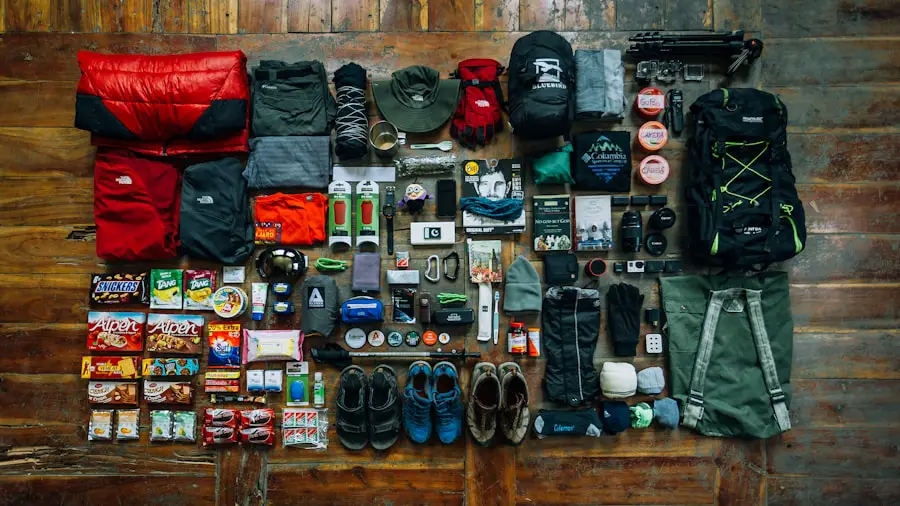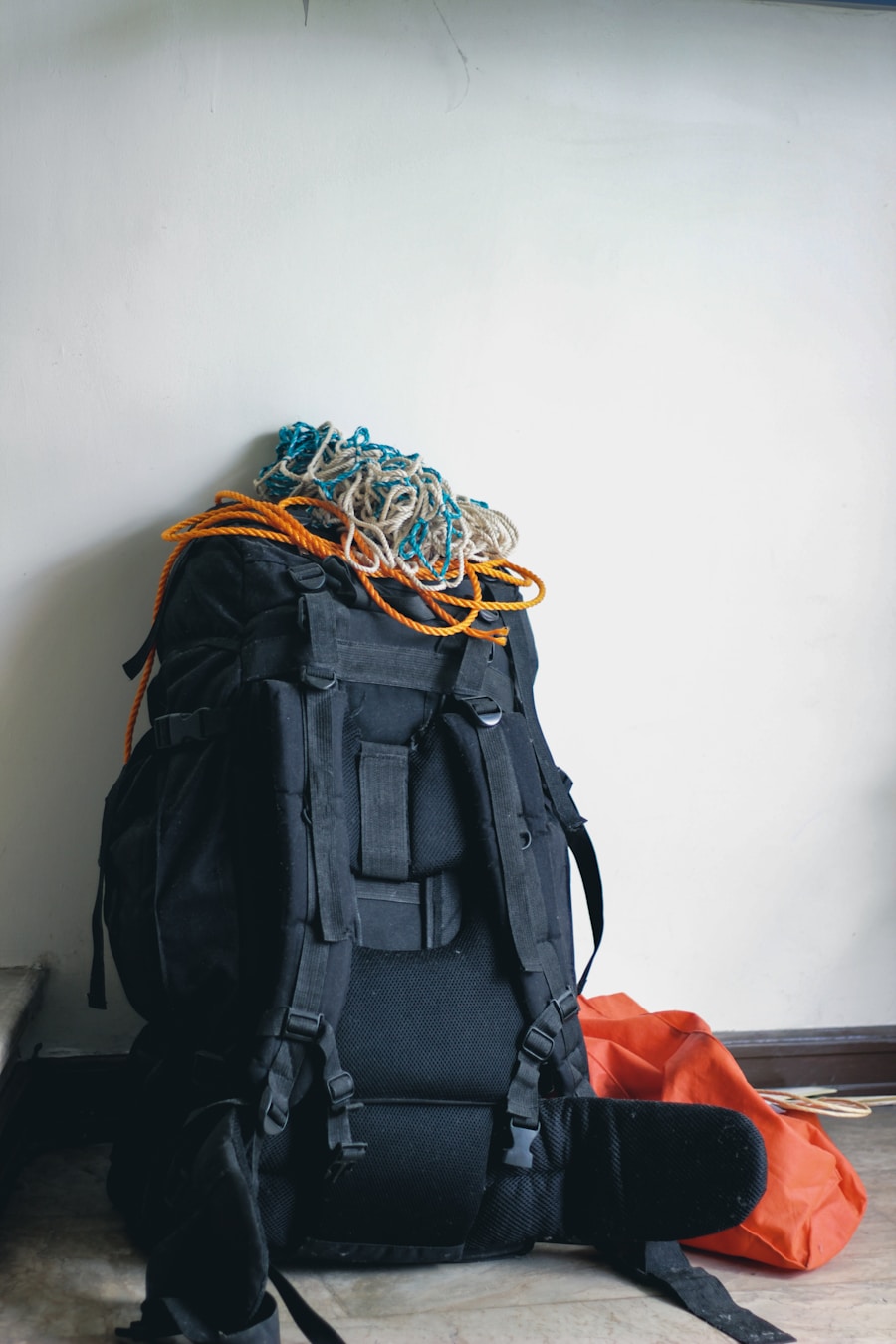Selecting the appropriate rucksack is a critical first step in preparing for any outdoor adventure, whether it be a day hike, a weekend camping trip, or an extended trek through rugged terrain. The right rucksack not only enhances comfort but also significantly impacts your overall experience. When choosing a rucksack, consider factors such as capacity, fit, and features.
Rucksacks come in various sizes, typically measured in liters, ranging from small daypacks of around 20 liters to larger backpacks exceeding 70 liters for multi-day excursions. A good rule of thumb is to select a pack that can comfortably hold all your gear while still allowing for easy access to essentials. Fit is another crucial aspect to consider when selecting a rucksack.
A poorly fitting pack can lead to discomfort and fatigue, especially during long hikes. To ensure a proper fit, it’s advisable to try on different models while wearing the clothing you plan to use on your trip. Pay attention to the length of the torso and the adjustment straps; many rucksacks come with adjustable harness systems that allow you to customize the fit to your body shape.
Additionally, look for features such as padded shoulder straps, a hip belt for weight distribution, and ventilation systems that help keep your back cool during strenuous activities.
Key Takeaways
- Choose a rucksack with adjustable straps and padding for comfort and support
- Pack heavier items closer to your back and lighter items towards the outside for better weight distribution
- Use packing cubes or stuff sacks to keep your gear organized and easily accessible
- Essential items to pack include a map, compass, first aid kit, and emergency whistle
- Opt for lightweight and multi-purpose gear to save space and reduce overall pack weight
- Pack high-energy snacks and a water filtration system for food and water considerations
- Include emergency supplies such as a space blanket, fire starter, and basic first aid items
- Perform a final check to ensure everything is secure and make any necessary adjustments before hitting the trail
Packing for Comfort and Safety
Weight Distribution
A well-packed rucksack should have heavier items placed close to your back and higher up in the pack. This positioning helps maintain your center of gravity, making it easier to navigate uneven terrain. Lighter items can be packed towards the bottom or in external pockets for easy access.
Accessibility of Gear
In addition to weight distribution, consider the accessibility of your gear. Items that you may need frequently, such as snacks, maps, or a first aid kit, should be packed in outer pockets or at the top of your rucksack. This organization allows you to quickly grab what you need without having to dig through your entire pack.
Avoiding Overstuffing
Furthermore, ensure that your rucksack is not overstuffed; a bulging pack can lead to discomfort and make it difficult to maneuver through tight spaces or dense vegetation.
Organizing Your Gear

Effective organization within your rucksack can make a significant difference in how smoothly your outdoor experience unfolds. Utilizing packing cubes or dry bags can help compartmentalize your gear, making it easier to find specific items without rummaging through your entire pack. For instance, you might designate one packing cube for clothing, another for cooking supplies, and a third for personal items like toiletries and electronics.
This method not only keeps your gear tidy but also provides an added layer of protection against moisture and dirt. Another useful strategy is to create a system based on frequency of use. Items that you will need at the beginning of your trip, such as a rain jacket or snacks, should be easily accessible at the top of your pack or in external pockets.
Conversely, items that you won’t need until later in the trip, like sleeping bags or extra layers, can be packed deeper within the rucksack. Additionally, consider using color-coded bags or labels to quickly identify contents at a glance. This level of organization can save time and reduce stress when setting up camp or preparing for a hike.
Essential Items to Pack
| Item | Quantity | Importance |
|---|---|---|
| Clothing | 3-5 sets | High |
| Toiletries | Travel-sized | High |
| Medication | As needed | High |
| Travel documents | Passport, tickets, etc. | High |
| Electronics | Phone, charger, etc. | Medium |
| First aid kit | Basic supplies | Medium |
| Snacks | Non-perishable | Low |
When preparing for an outdoor adventure, certain essential items should always be included in your rucksack to ensure safety and comfort. A reliable shelter system is paramount; this could be a tent, hammock, or tarp depending on your preferences and the environment you’ll be in. Alongside shelter, a sleeping system comprising a sleeping bag rated for the expected temperatures and a sleeping pad for insulation and comfort is crucial for restful nights outdoors.
Clothing is another essential category that requires careful consideration. Layering is key; packing moisture-wicking base layers, insulating mid-layers, and waterproof outer layers will help you adapt to changing weather conditions. Don’t forget accessories such as hats, gloves, and extra socks, which can make a significant difference in comfort levels during colder conditions.
Additionally, packing a reliable navigation system—whether it’s a map and compass or a GPS device—is vital for ensuring you stay on track during your journey.
Lightweight and Multi-Purpose Gear
In recent years, the trend towards lightweight and multi-purpose gear has gained traction among outdoor enthusiasts. The benefits of reducing pack weight are manifold; lighter gear can enhance mobility and reduce fatigue over long distances. When selecting equipment, look for items that serve multiple functions.
For example, a multi-tool can replace several individual tools while taking up minimal space and weight in your pack. Another excellent example of multi-purpose gear is a sleeping bag that can also function as an insulated liner for your backpacking quilt or as an extra layer during cold nights. Similarly, consider packing collapsible cookware that can double as storage containers when not in use.
Investing in lightweight materials such as titanium or high-quality synthetic fabrics can also contribute to reducing overall pack weight without sacrificing durability or performance.
Food and Water Considerations

Food and water are fundamental components of any outdoor adventure, and careful planning is necessary to ensure you have enough sustenance while minimizing weight. When selecting food items, opt for lightweight options that are high in calories and easy to prepare. Freeze-dried meals are popular among backpackers due to their convenience and long shelf life; they require only boiling water for preparation and can provide substantial nutrition with minimal bulk.
Water management is equally important; staying hydrated is crucial for maintaining energy levels on the trail. Depending on the availability of water sources along your route, you may need to carry sufficient water or have a reliable filtration system in place. Hydration bladders are an excellent choice for easy access while hiking; they allow you to sip water without stopping frequently.
If you’re traveling through areas with known water sources, consider carrying a lightweight water filter or purification tablets to ensure safe drinking water without the added weight of carrying large quantities.
Emergency and First Aid Supplies
No outdoor adventure is complete without adequate emergency and first aid supplies. Accidents can happen even on well-planned trips; therefore, being prepared can make all the difference in ensuring safety and well-being. A well-stocked first aid kit should include essentials such as adhesive bandages, antiseptic wipes, gauze pads, adhesive tape, pain relievers, and any personal medications you may require.
It’s also wise to include items like blister treatment supplies and insect repellent. In addition to first aid supplies, consider packing emergency items such as a whistle for signaling help, a compact emergency blanket for warmth, and a fire starter kit for creating warmth or signaling rescue teams if necessary. A headlamp with extra batteries is invaluable for navigating after dark or during emergencies when visibility is low.
Familiarizing yourself with basic first aid techniques before heading out can also empower you to respond effectively should an injury occur.
Final Check and Adjustments
Before embarking on your adventure, conducting a final check of your rucksack is essential to ensure everything is in order. Start by reviewing your packing list to confirm that all essential items are included and accounted for. This checklist should encompass all categories discussed earlier: shelter systems, clothing layers, food supplies, water management tools, first aid kits, and emergency gear.
Once you’ve confirmed that all items are packed, take the time to adjust your rucksack properly before hitting the trail. Ensure that all straps are tightened appropriately; this includes shoulder straps, hip belts, and load lifters if applicable. A well-adjusted rucksack will distribute weight evenly across your body, reducing strain on your back and shoulders during long hikes.
Finally, take a moment to test the fit by walking around with the loaded pack; this will help identify any discomfort or areas needing adjustment before you set off on your journey into the great outdoors.
When preparing for a hiking trip, it’s important to pack efficiently to ensure you have everything you need without carrying unnecessary weight. One essential item to consider bringing along is a travel pillow for long flights, such as the ones recommended in this article to find the perfect one for your trip.
Love travel? Join Our Facebook Community
FAQs
What is a rucksack?
A rucksack, also known as a backpack, is a type of bag that is carried on the back and is often used for hiking, camping, and other outdoor activities.
Why is it important to pack a rucksack properly for hiking?
Packing a rucksack properly for hiking is important to ensure that the weight is distributed evenly, the contents are organized for easy access, and the load is comfortable to carry over long distances.
What are the essential items to pack in a rucksack for hiking?
Essential items to pack in a rucksack for hiking include water, food, a map and compass, a first aid kit, extra clothing layers, a headlamp or flashlight, a multi-tool, and a fire starter.
How should I distribute the weight when packing a rucksack for hiking?
When packing a rucksack for hiking, it’s important to distribute the weight evenly by placing heavier items closer to the back and towards the middle of the pack. This helps to maintain balance and stability while hiking.
What are some tips for packing a rucksack for hiking?
Some tips for packing a rucksack for hiking include using stuff sacks or packing cubes to organize and compress clothing and gear, packing items that are needed during the day in easy-to-reach pockets, and using the outer straps to secure items like a sleeping pad or tent.
How should I adjust the straps on a rucksack for hiking?
When wearing a rucksack for hiking, it’s important to adjust the shoulder straps, hip belt, and sternum strap to ensure a comfortable and secure fit. The hip belt should sit on the hips, the shoulder straps should be snug but not too tight, and the sternum strap should be positioned at chest level.
